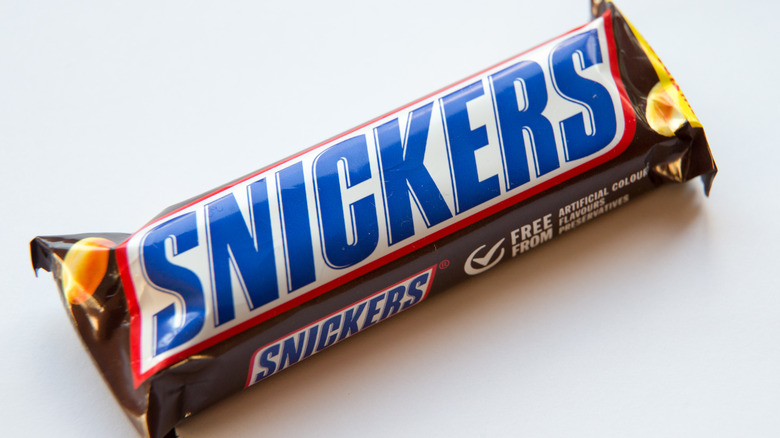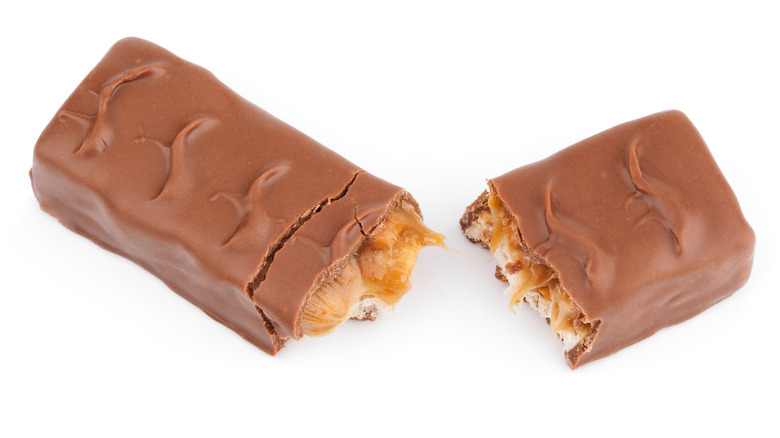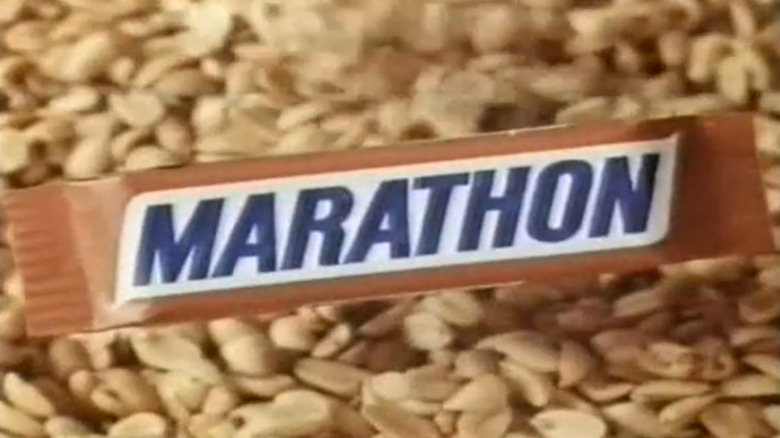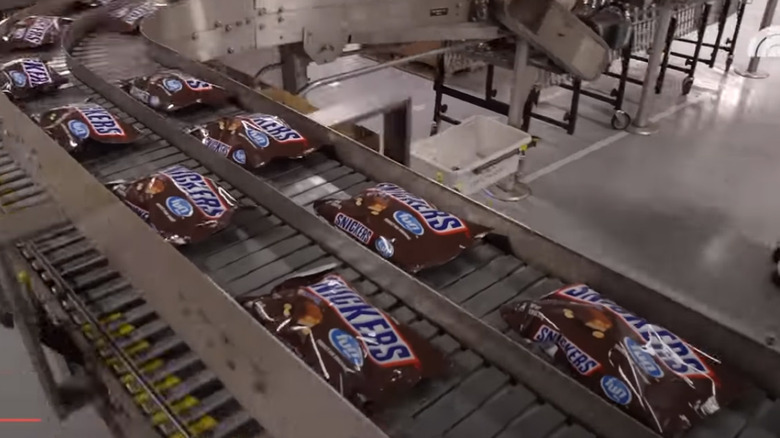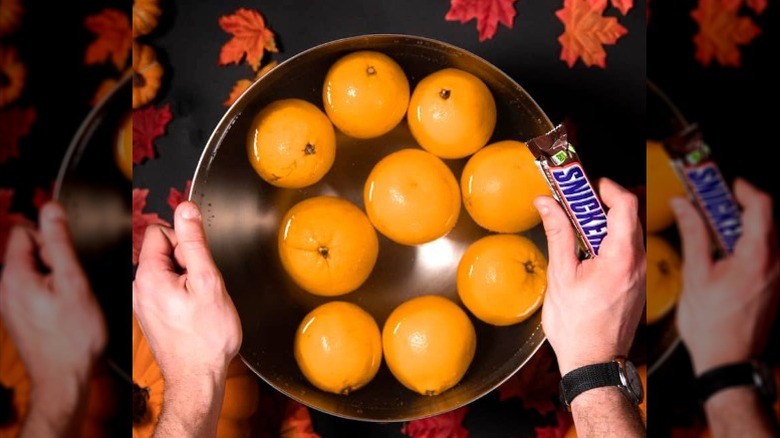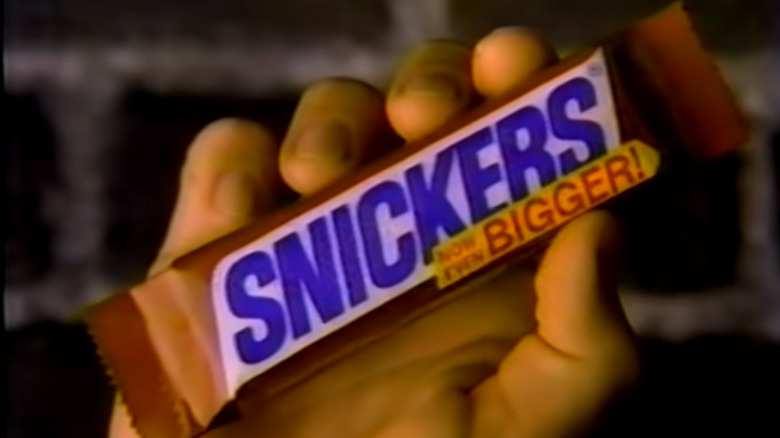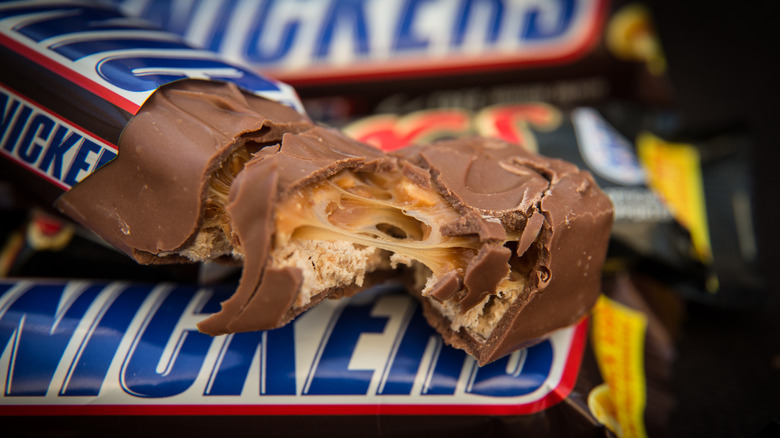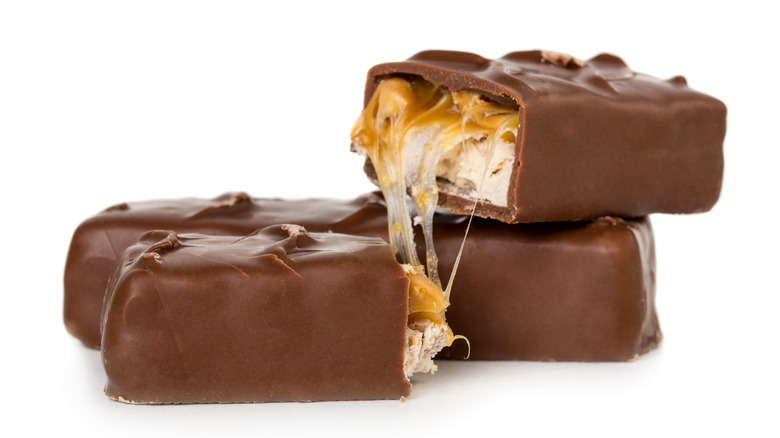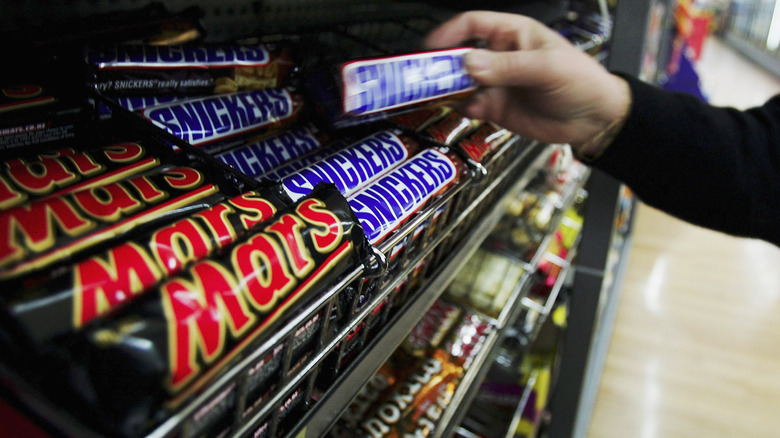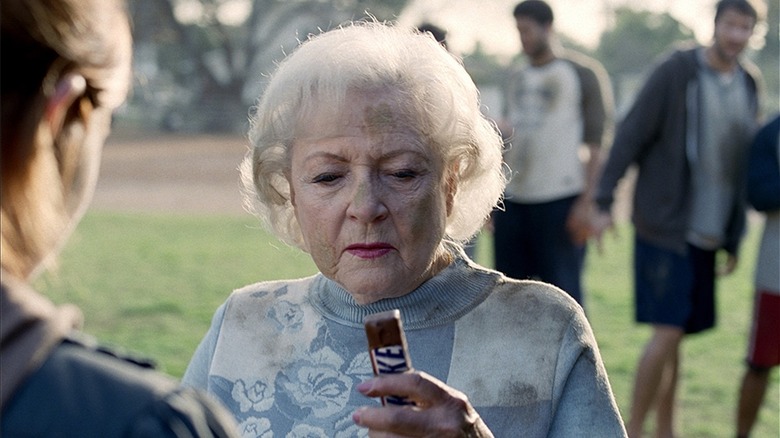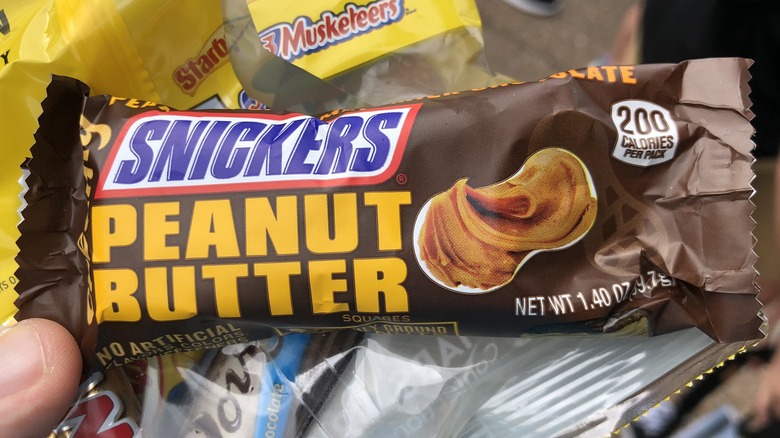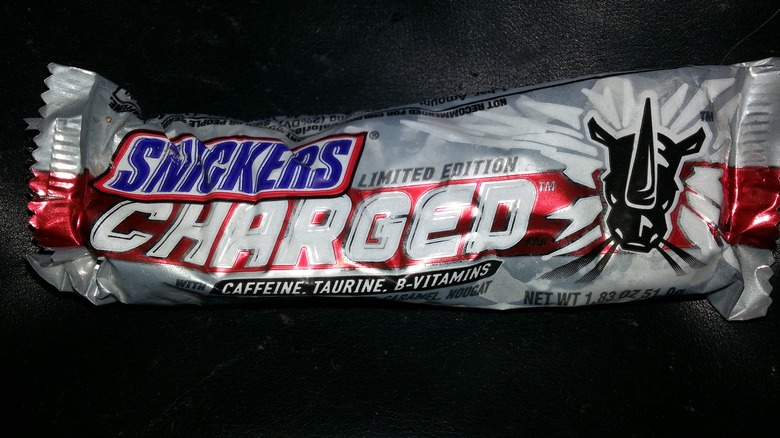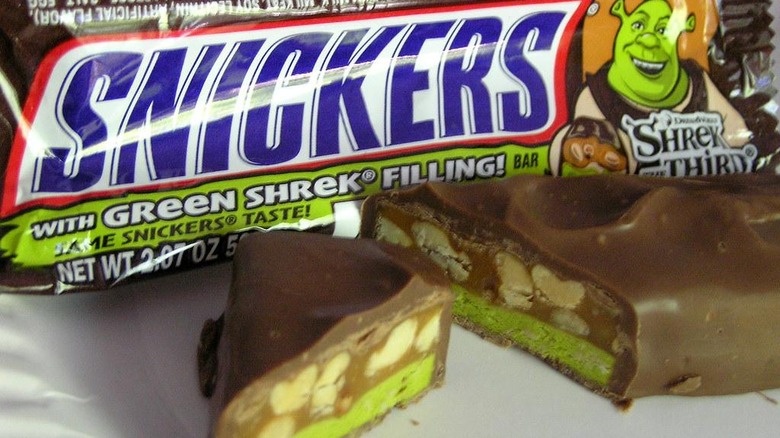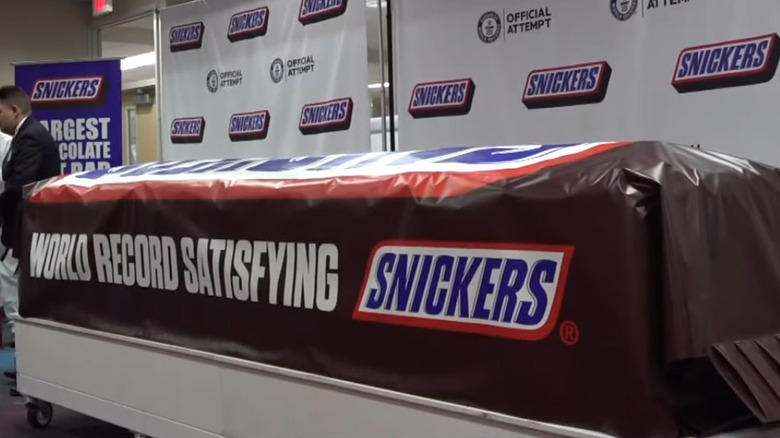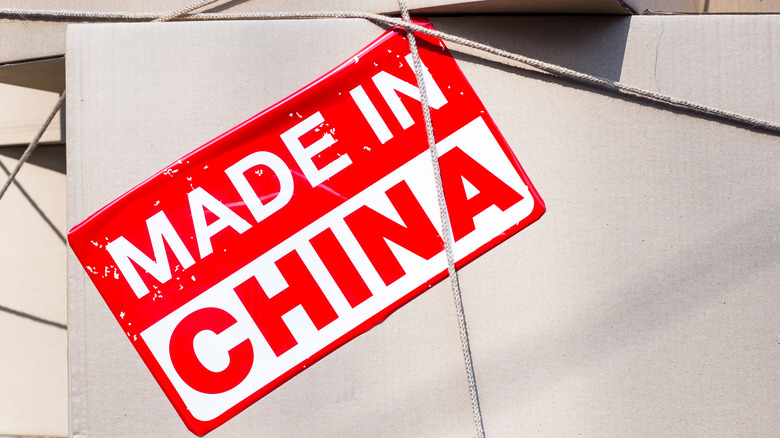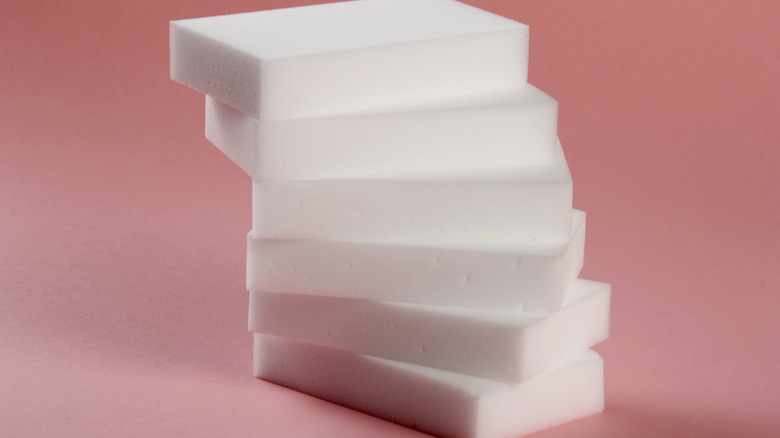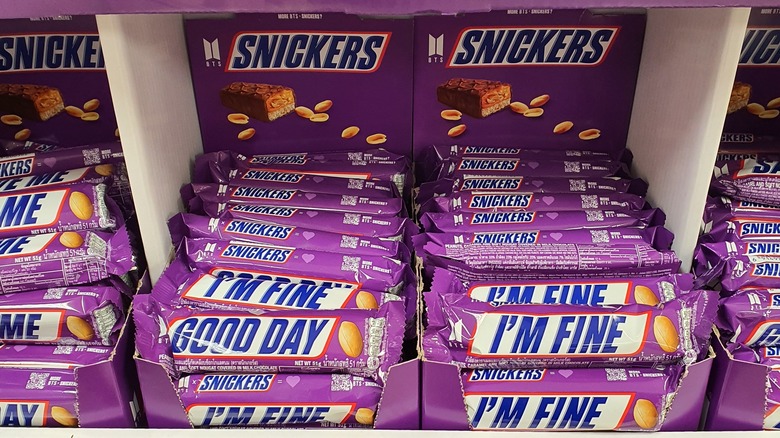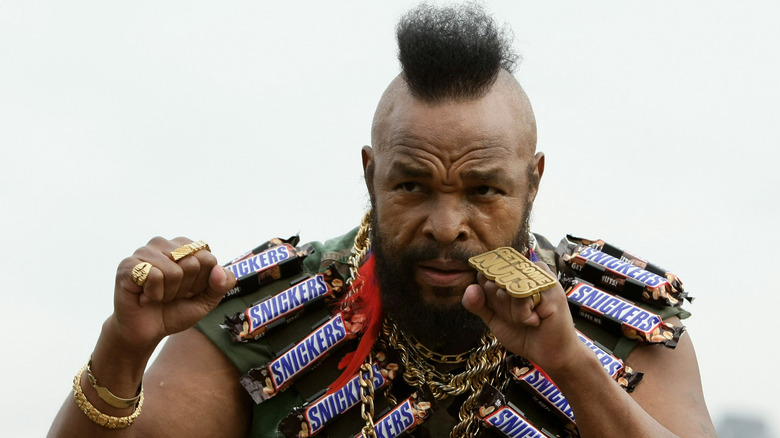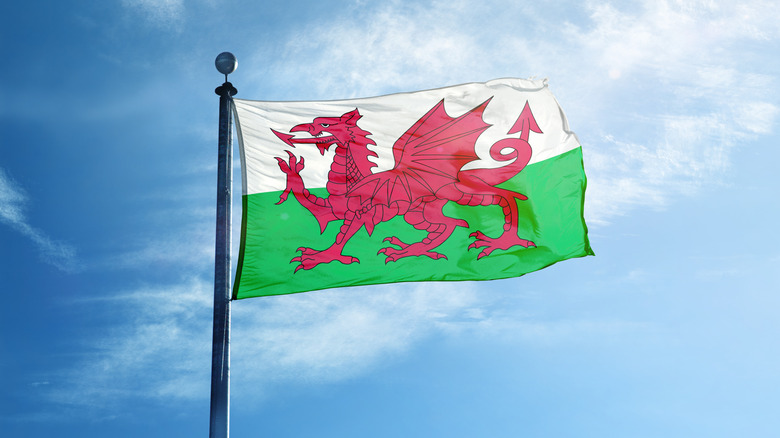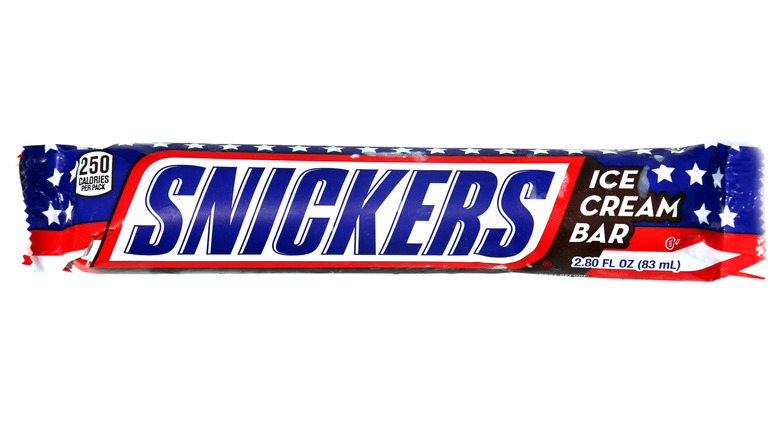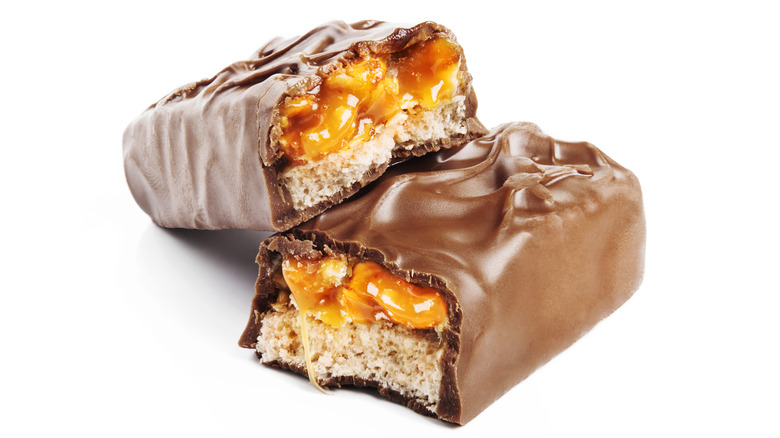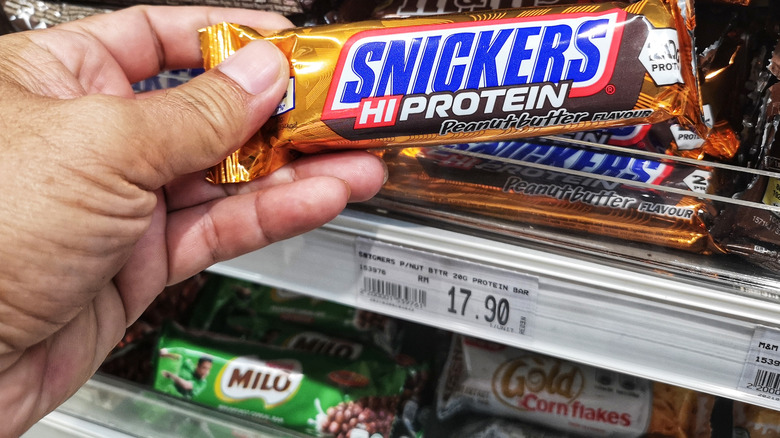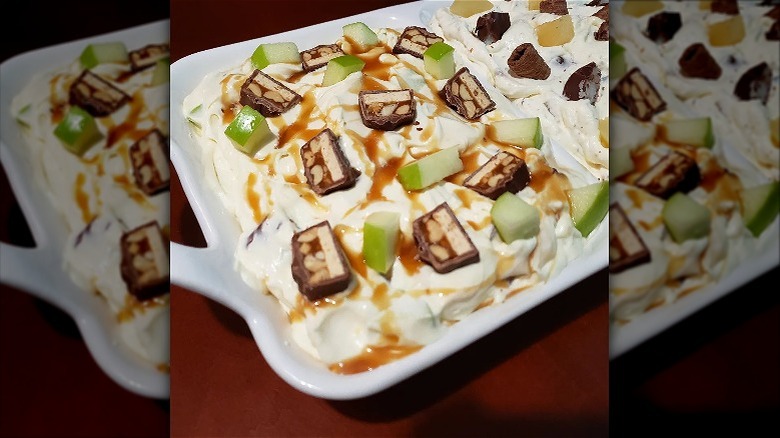Snickers: 22 Facts About The Popular Candy Bar
Chocolate, of course, has been around for thousands of years, but it wasn't until the later part of the 19th-century that candy confectioners started putting things like marshmallows, peanuts, and caramel into the chocolate and selling it to the public as candy bars (via Forbes).
One of the earliest candy bar sensations that is still going incredibly strong today is Snickers, with Mars pumping out 15 million of them every day (via NBC News). The chocolate bar with a peanut, caramel, and nougat filling has been satisfying the hunger of candy-lovers for 90 years. Whether it's enjoyed in the fun-size version by kids at Halloween or claiming a Guinness World Record for the largest candy bar, there's no denying that Snickers is one of the world's most popular candy bars.
With such a long legacy, the candy bar has seen its share of highs and lows and come under fire more than once for its high-calorie content. From its early beginnings to most-recent milestones, here's everything you ever wanted to know about this American candy bar giant.
The Snickers candy bar is named after a horse
The Snickers candy bar didn't come into existence until 1930 and by that time its creators, Frank and Ethel Mars were already incredibly successful. Frank Mars had started out quite poor to the point that his wife left him because his candy business was going nowhere (via Made in Chicago Museum). Frank Mars did eventually hit it big though with another popular candy bar in 1922 — the Milky Way.
So what does any of this have to do with Snickers? Well, the Milky Way was so successful that it made Frank and his second wife (also named Ethel, by the way) bona fide candy moguls. With all the money rolling in, Frank took up some pretty pricey hobbies and one of them was horse breeding. The guy didn't just buy a couple of horses to ride on weekends either. No, Frank and Ethel went big and purchased a 3,000-acre farm called Milky Way Farms that employed 100 people in Tennessee.
One of Ethel's favorite horses was a prized racehorse that died shortly before Frank Mars' new version of Milky Way with the addition of peanuts went into production (via Rewind & Capture). In honor of the horse named Snickers, the couple decided to name the new candy bar as a tribute.
It wasn't even called Snickers in the UK
Americans may have been eating Snickers since 1930, but folks in the U.K. didn't start eating Snickers bars until 1990. This is because, for years, the candy bar wasn't called Snickers but was known instead as a Marathon bar.
As for the primary reason that Mars opted to call it a "Marathon" bar rather than Snickers? Well, they were essentially worried that people would think it was a joke since Snickers rhymes with "knickers," the British slang for women's underwear. In 1990, they decided to use one name for the candy bar all around the world. Mars phased the Snickers name in with the packaging reading both Marathon and Snickers, so as not to confuse customers, until Marathon was eventually dropped altogether.
In a tribute to the candy bar's past, Mars reissued a throwback run of Marathon bars in 2019 for a limited nine-week run (via Runner's World). The candy bar was exactly the same — only the wrapper was different.
Mars begins making Snickers for Halloween months in advance
Snickers may not be the most popular or best-selling Halloween candy — that distinguished title goes to Reese's — but it is a ridiculously hot item. The candy bar rakes in millions in sales every October and in order to make sure there's enough peanut and chocolate goodness to go around, Mars has to start making them months in advance.
According to Mars Wrigley's chief operating officer, Vic Mehren, Halloween is the Super Bowl for Snickers. "We're thinking about Halloween well before [it] happens, so it is a constant all year long preoccupation for us, for sure," Mehren told Today.
Mehren said that the Mars factory in Oak Park, Illinois starts making Snickers and other candy that will be sold at Halloween the spring before trick or treaters take to the streets. The factory pumps out Snickers "throughout the entire summer" in order to have everything shipped out and on store shelves by September.
While Mehren didn't drop any specific numbers as to how many Snickers bars are sold during the Halloween season, more than 400 million are sold during the course of a year (via Eat This Not That!).
Snickers tried to change the date of Halloween
Being that Halloween is such a monumental time for Snickers, the candy bar does have some weight it can throw around regarding the holiday.
Halloween, of course, falls on October 31 and many years it falls on days of the week that aren't exactly party-friendly. October 31 was on a Thursday in 2019, for example. Not the worst day, but not as good as Saturday either. In 2019, Snickers joined a movement to officially make Halloween the last Saturday in October (via Fox News).
Snickers didn't merely say that they thought it was a good idea to change the date of Halloween, but actually gave an incentive to do so. "A Thursday Halloween? Not Satisfying," read a tweet from Snickers. "Halloween on the last Saturday of October? Satisfying. If the Fed Govt makes it official, we'll offer 1 million free SNICKERS to America."
All of a sudden the push to move Halloween didn't sound so terrible anymore. "Signed!! Totally down for this with 3 school-aged kids," said one person. Others, though, weren't so cool with the idea and directed Snickers to "stay in their candy lane" and told the brand "I thought my love of Snickers was sacred, but we just broke up over this."
Obviously, Halloween is still on track for October 31 this year. Nice try, Snickers.
Nutritionists weren't happy about Snickers being an Olympic sponsor
The Snickers candy bar — along with M&Ms — was designated as the official snack food of the 1984 games and nutritionists were less than pleased (via UPI). "The present labeling is misleading in that it leads consumers to believe that these candies are endorsed by the Olympic Games as a nutritious snack food choice," dietitian Edward C. Goodstein said at the time.
Mars secured its "official snack" endorsement of Snickers by paying the Olympics $4 million dollars along with free candy for all of the competing athletes.
Goodstein and other nutritionists were concerned the promotion would lead "little kids [to] figure that if they eat Snickers or M&Ms they will become athletes." It was a pretty fair argument too, especially when Snickers had athletes like alpine skier Karl Anderson promoting it in commercials and saying that eating a Snickers "allows me to concentrate on downhill."
Snickers didn't back down and had their own candy nutritionist defend the sponsorship. "Athletes do have greater demand for energy and candy is one way to get it," Dr. Daniel Rosenfield said.
In case you're curious, Anderson didn't need Snickers to "concentrate on downhill" at the '84 games because he didn't even compete (via News Center Maine).
Snickers are a little smaller than they used to be
Despite what the Snickers of the 1984 Olympics would have you think, Snickers is by no means a health food. Sure, this is probably a "duh" moment for most folks, but Mars has been blasted by nutritionists for years and that criticism reached a boiling point in 2012.
Spurred by public health movements like Michelle Obama's Let's Move! campaign, Mars decided that it would work to help combat the childhood obesity epidemic rather than contribute to it (via Reason). This meant reducing the size of the standard 280-calorie Snickers bar by 12 percent.
Yes, Mars did roll out the standard public relations response of "Mars chocolate products should be enjoyed in moderation as part of a healthy and well-balanced lifestyle," but they did somewhat try to make a positive change (via CNN Money).
In addition to shrinking the regular Snickers, Mars said they'd be swapping the hefty king-size version for a "2toGo" version that contained two Snickers bars of 220-calories each in a resealable package. Whether or not customers actually save the second bar for later though, is up to their own willpower.
A viral internet rumor falsely claimed Snickers cause cancer
The internet has certainly seen its fair share of strange rumors and one of the weirdest that thankfully turned out to be bogus happened just a few years ago.
Back in 2016, Mars voluntarily recalled a ton of its chocolate from 55 countries because a bit of plastic was found in a Snickers bar (via The Guardian). That should have been the end of it, but then a video clip posted by Euronews showed heaps of Snickers being tossed into a firey pit because of the recall. There was no mention of cancer in the video clip, but regardless, a group called "foodielock.com" began circulating the video claiming the Snickers destruction was because it caused cancer (via BuzzFeed).
Pretty soon, the post had been shared some 53,000 times where it was picked up by more dubious fake news sites. Long story short, eating a bunch of Snickers might cause your waistline to expand, but the scientific community hasn't blacklisted Snickers as a cancer-causing agent.
Snickers probably helped save a man's life
As Colorado outdoorsman Christian George would later admit in 1998, "Mother Nature up in these mountains is not something to play with." George was on a snowmobiling trip when he got separated from his group and buried in an avalanche (via Steamboat Pilot & Today).
The only things he had in his pockets at the time were two cigarette lighters and America's favorite candy bar — Snickers. "When I stopped for gas in the morning, I picked up a little pint of orange juice and a king-size Snickers bar. And, unfortunately, I left the pint of orange juice in my car," George told CBS.
Half-frozen, George was able to free himself from what could have been a snowy grave and over the course of four days, crawled through the waist-deep snow until he was spotted by a helicopter.
In order to keep his strength up, George was careful to ration his Snickers bar a bite at a time. This was back when a king-size Snickers had 510 calories and while he did lose 23 pounds during his harrowing ordeal, he would have been worse off, if not dead, if he didn't have that Snickers. Had George not been busted for illegally growing marijuana a week later, who knows? He maybe could have been a Snickers spokesperson.
Snickers' hangry celebrity ads have been a massive success
Snickers early TV commercials were animated ads geared at kids, but these days they're better-known for ads with hangry celebrity icons like Joe Pesci and Betty White. The Snickers "you're not you when you're hungry" commercials helped reverse a downward trajectory that the brand was facing prior to launching the ad strategy (via Campaign).
The first of the ads featured Abe Vigoda and Betty White in a touch football game that aired in 2010 during the Super Bowl. It didn't just do well, but was the best-performing commercial of the game that year (via PR Newswire). That initial ad generated an incredible 400 million in unpaid media impressions worth around $28.6 million.
More Snickers commercials obviously followed with everyone from Robin Williams to Aretha Franklin. Even fictional monsters the Gremlins found their way into the commercials. Popular commercials with celebrity cameos are pretty good for business and Snickers saw their sales increase by nearly 16 percent. As Campaign pointed out, that's not too shabby for a brand that was 80-years-old at the time.
You can now get a Snickers with peanut butter instead of peanuts
One of the more recent Snickers flavors removed the peanuts altogether and instead swapped in creamy peanut butter. "We listened to our consumers' desires for new tastes like almond butter and paired it with an innovation on texture," brand director Josh Olken said (via Insider). Olken went on to say that it allowed for a "Snickers satisfaction in both crunchy and smooth."
Unlike the regular Snickers candy bar, the peanut butter version actually came in small square sizes. As for how good a candy is that clearly wanted to steal some of Reese's Cups thunder, reviews were a bit lukewarm. The Spruce Eats tasted the version that came with both peanut butter and peanuts, and said the combination of peanut butter and nougat made the taste of the caramel virtually invisible and that it had a gritty texture. Gritty is never a positive way of describing a chocolate candy bar.
The candy bars also came in almond and maple butter versions which, again, got somewhat of a mixed reception. While Taste of Home's reviewer really liked the peanut butter and almond butter versions, the maple butter was a bit too sweet for their taste.
Mars briefly tried a caffeinated Snickers bar
The folks at Mars are always experimenting with ways to add a new twist to Snickers. Sometimes it's simply adding more of what's already inside — caramel and peanuts — other times it's a bit more bizarre.
The strangest Snickers to date, though, has to be the candy bar's attempt to transform itself into a caffeinated energy bar. Perhaps the Snickers that was fueling athletes at the '84 Olympic games just wasn't cutting it anymore.
In 2008, Snickers launched Snickers Charged, a candy bar that in addition to its usual peanuts also included taurine and 60 milligrams of caffeine. "[It] offers consumers a bar of substance and a delicious and satisfying way to tackle the afternoon hours when one needs to repower," Mars Vice President Michele Kessler told the NY Daily News.
Even though the candy bar contained slightly less caffeine than a cup of coffee, dieticians like Tina Fuchs were concerned more about the 250 calories of sugar people would be consuming "every time they need an energy boost."
Snickers Charged wasn't the first time a candy bar tried to take on Red Bull and other energy drinks. Butterfinger tried it a year later. According to Deseret News, Snickers Charged was only meant to be a limited-time candy unless it really took off... which it didn't.
A limited run of Snickers had green filling
As Snickers has proven with their caffeinated candy bar, they're not against thinking outside the box and getting a bit weird with their candy creations. One of the strangest has to be the time they decided to change the color of nougat inside their candy bar to green.
Mars wanted to get people hyped about the third installment of the Shrek film franchise in 2007, so they created a limited run of Snickers that were the same color on the inside as the green ogre (via Candy Blog). The wrapper's message promised Snickers fans that the candy bar still delivered on the "same Snickers taste" only now "with green Shrek filling." That almost makes it sound like Mars put poor Shrek in the candy bars.
While fans of Shrek might have been on board with green Snickers, the candy bar did bring out some critics who took issue with Shrek's junk food associations. An editorial piece in The New York Times, for example, said Shrek was sending a "mixed message" to kids by both appearing in public service announcements to encourage kids to exercise and promoting junk food like Snickers and Twinkies.
The largest Snickers bar weighed two tons
Nothing makes for good brand marketing like securing a place in the book of Guinness World Records, and Snickers kicked off 2020 by doing just that. Mars set out to create a candy bar that would make every other candy bar out there look like a puny fun-size version by making one that weighed in at over two tons (via Candy Industry).
Just like a regular Snickers bar, this giant version still had peanuts, caramel, and chocolate — just a lot more of it. The candy bar was made with 3,500 pounds of milk chocolate and 1,200 pounds of peanuts, caramel, and nougat to help celebrate two different anniversaries for Snickers.
"We're not only celebrating the 90th anniversary of the brand, but the Super Bowl will also mark ten years since the iconic 'Game' spot launched the award-winning 'You're Not You When You're Hungry' campaign," Snickers' director of sales, Josh Olken said. "What better time than the Super Bowl to satisfy something on the biggest scale yet?"
The massive size of the giant Snickers was the equivalent of 41,000 regular Snickers bars and would be consumed by the 600 Mars Wrigley workers in Waco, Texas who helped make it... along probably just about everyone else in Waco. Unfortunately for Snickers, they didn't hold the record long. Reese's Take 5 stole the record just a couple weeks later.
Australians were unhappy to learn Snickers were once made in China
According to Indy100, Mars is a seriously big candy company in Australia; perhaps this is why fans were shocked to discover that Snickers were no longer being produced there, In 2021, a TikTok showed a Snickers bar from an Australia Woolworths that was produced in China. The change in production location had happened back in March 2020, according to Indy100.
A representative from Mars Wrigley told Daily Mail that production was temporarily moved to Jiaxing, China, due to renovations at the company's Ballarat, Australia, production plant. No Australian jobs were terminated because of the temporary move, the representative claimed. In 2022, Snickers bars were again manufactured in Australia but were about 12% smaller than before, according to The Guardian. A representative from Mars Wrigley said that an increase in operations costs and other factors led to this "shrinkflation," but did not say if other candy bars had experienced the same effect.
Watchdogs found traces of melamine in Snickers
Food contamination is nothing new, but that doesn't make it any less jarring or scary. Mars Wrigley is no exception as, in 2008, food watchdogs in South Korea discovered that M&M's, Snickers, and Kit Kat bars produced in China included substantial amounts of melamine (via Korea Times). Melamine, an industrial chemical, is often used to manufacture cooking utensils and kitchenware, as well as sponges and fertilizer. It can be toxic if ingested. According to Confectionary Production, many food regulations state that products cannot contain more than 2.5 milligrams of melamine per kilogram.
Around the same time, melamine-laced dairy and milk powder products killed four and injured around 50,000 people in China (per Korea Times). Meanwhile, Cadbury had to pull its Cadbury Eclairs produced in Beijing, China, also because they contained excessive amounts of melamine (via Confectionery Production). It does not appear that anyone was harmed directly by cross-contaminated Snickers candy bars.
Consumers were upset when Snickers apologized to China
Snickers hasn't just had beef with Australia, but also China. It all began with a Snickers collaboration with K-pop boy band, BTS. One of the promotion's advertisements referred to Taiwan as a country independent from China. Mars quickly apologized for the misstep, adding that the brand "respects China's national sovereignty and territorial integrity" and that "Taiwan is an inalienable part of China's territory" (via Taipei Times).
Even though China was quick to move on, others were not so forgiving. News.com.au reported that fans on Twitter slammed Mars Wrigley for caving into the "bullies" and not acknowledging the loaded past between China and Taiwan. This controversy came just as the U.S. Speaker of the House, Nancy Pelosi, visited Taiwan, straining ties between the U.S. and China on high-stakes issues such as climate change. Perhaps Snickers lay low for a while, lest it cause yet another international incident.
A Mr. T Snickers commercial had to be taken off the air
Snickers is known for its in-your-face marketing, especially some high-intensity commercials. So, it wasn't all that surprising when Mr. T starred as the highly macho and over-the-top presence that made Snickers commercials some of the most recognizable advertisements on TV. However, a 2008 U.K. commercial starring the actor took things over the edge.
The commercial in question opens with a man speed walking until Mr. T launches out of a house in a souped-up truck equipped with a Snickers-filled machine gun. He calls the speed walker "a disgrace to the man race" and tells him that "it's time to run like a real man" as he fires Snickers bars at him (via The Guardian).
Even though the advertisement received only two complaints in the UK, it was criticized by the Human Rights Campaign as a portrayal of violence against LGBTQ+ people. Though Mars claimed that it meant not harm, that wasn't the only homophobic Snickers commercial to air. One Spanish ad was pulled after it was also accused of perpetuating negative stereotypes of LGBTQ+ people (via BBC).
A tweet from Snickers offended the Welsh
We know that Snickers is no stranger to slightly distasteful marketing. In that vein, some 2020 tweets from Snickers UK landed the brand in the hot seat. When the brand tweeted "A place in Wales or someone sat on a keyboard? A thread." and commented with names like "Llanfairpwllgwyngyll." Before it was quickly deleted, Welsh people were up in arms over the insensitive tweet chain (via Nation.Cymru).
Some Twitter comments called the tweet an insult to the Welsh language and culture, while others pledged to boycott the brand entirely. Some comments stood up for the Snickers brand, calling the tweet a harmless joke. These comments further enraged some, who claimed that more people would be upset if any other language was the butt of the joke (via HuffPost). Hours after the tweet was deleted, Snickers U.K. posted an apology on Twitter, praising the loyalty of the Welsh fans.
Snickers ice cream bars debuted in the 1980s
A Snickers bar by itself is delicious, but adding ice cream can only make it better, right? Released in 1989, the Snickers Ice Cream Bar is everything you love about a classic Snickers bar but with a twist — it contains peanut butter ice cream instead of nougat. Some fans on Influenster proclaim that it's texturally better than the normal candy, while others said that it was the perfect fulfillment of a pregnancy craving.
In 2021, Mars Wrigley announced the release of its Snickers Peanut Brownie Ice Cream Bar, which is effectively the ice cream bar with pieces of brownie added to the mix (via PR Newswire). However, the company isn't done yet. According to Food Dive, the company wants to expand its ice cream reach to earn $1.1 billion by 2024. Thanks to popular frozen treats like the Twix, Snickers, and Kind ice cream bars, sales hit $6.5 billion in the U.S. ice cream market in 2021.
An outcry arose when Snickers reportedly removed its veins
One of Snickers most iconic characteristics, aside from its perfectly layered center, is its swirled surface. Fans affectionately call it the veins of the candy bar. However, fans were shocked and disappointed when a smooth and silky Snickers bar went viral on Twitter in 2022. A web of seemingly fake news grew from there.
One manufacturered screenshot shared via Twitter depicted conservative news anchor Tucker Carlson slamming the "woke mob" for removing the suggestive Snickers veins. Some fans believed it was real given Carlson's previous tirade about the desexualization of the M&Ms mascots (via Salon). However, PolitiFact revealed that the image was nothing more than a meme.
In response to the outcry, Snickers assured fans that the veins were going nowhere (via Twitter). However, a 2013 Reddit post shows the same photo of the smooth Snickers. In response to the confusion, a former Mars Wrigley plant worker explained that the iconic veins are made using a "decorator belt" and sometimes one might miss that step in the manufacturing process (via Reddit).
Snickers protein bars are not as healthy as you think
Most of the time, protein bars are little more than dense, grainy granola bars that try and often fail to replicate comfort food favorites like cinnamon rolls and chocolate cake. Snickers tried to break the protein bar mold with its Snickers Hi Protein Bar, advertised as a delicious and filling snack with 20 grams of protein and four grams of sugar. The candy-protein hybrid line also includes a Snickers Hi Protein Powder with the same amount of protein and sugar as the bars, but with only 3.5 grams of fat.
Often, we assume that protein bars are the epitome of health — until you look at the fine print. Compare a standard Snickers candy bar to a Snickers Hi Protein Bar, and you'll make some surprising discoveries. They contain nearly the name number of calories, with the protein bar sitting at 220 and the candy bar at 250. While the Snickers protein bar has more vitamins, minerals, and protein, the Snickers candy bar has less total fat, cholesterol, and sodium. Both the candy and protein bar have a slew of sugars, artificial sweeteners, and some rather unintelligible ingredients. Ultimately, feel free to enjoy either, but don't be fooled by the protein bar's health-washed marketing.
People use Snickers bars to make other desserts
A Snickers bar by itself makes for a delicious and chocolatey dessert. The only improvement would be a combination of a Snickers and a different comfort food.We're talking recipes that ask cooks to chop whole Snickers candy bars, then add the bits to cakes, cookies, and other baked goods.
Consider the Snickers salad. This is by no means a kale salad. Instead, it harkens back to Midwestern-style sweet "salads." The Orange County Register noted the popularity of these salads at church events, particularly one Missouri group that routinely brought a Snickers salad to its potluck. According to 196 Flavors, Snickers salad is a popular dessert in places like Minnesota and Iowa and may have Norwegian roots. Similar to ambrosia salad, it contains a Cool Whip and Jell-O pudding base topped with marshmallows, caramel, Granny Smith apples, and chopped Snickers.
If Jell-O salad isn't your thing, there are always recipes like this Food.com version of Snickers dip. It contains a mixture of cream cheese, Cool Whip, brown sugar, and Snickers with pretzels for dipping. Don't forget about a sweet and salty dump cake, specifically this Betty Crocker version with chocolate cake and piles of peanuts.
